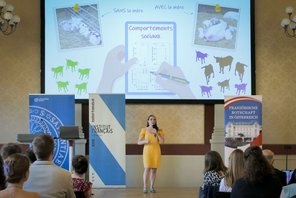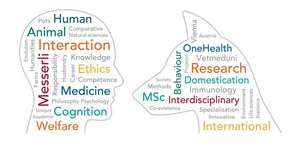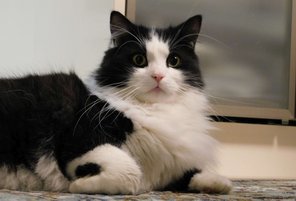- animal-welfare-science /
- Infoservice /
- News Archive
2022
The PLFdoc doctoral school on Precision Livestock Farming was accepted for funding by the Austrian Science Fund (FWF). PLFDoc is a collaboration between the Vetmeduni Vienna, the Technical University Vienna and the University of Applied Science Upper Austria. Research focus of the PLFDoc will be on application of computer vision for monitoring parturition in cows and pigs. The main aim of the PLFDoc is to enhance animal welfare, e.g. through early detection of dystocia and preventing the death of newborns and their dams in this sensitive period and other health- and welfare-related risks. Please visit the PLF-Hub homepage for further information
On Tuesday, June 7, 2022, 10 young researchers and Phd students from Austria, the Czech Republic and Poland took part in the Central European regional final of the competition "Ma thèse en 180 secondes - My dissertation in 180 seconds" in the ballroom of the University of Vienna part. ITT Phd student Claire Toinon won 1st prize in the regional finals and will now have the honor of representing Austria and Central Europe at the international finals of the competition in Montreal!
The candidates had exactly 3 minutes - using a single slide - to present their dissertation topic in French in simple terms. Claire Toinon is working on the influence of the early social environment and maternal deprivation on goats and goat kids’ social behaviour and psychobiological responses to stressful situations. Her PhD mainly focuses on positive social behaviour and compares how differently goats reared with and without their mothers interact with other individuals. Claire Toinon states, that MT180 was an excellent experience as she had to take a step back from the research itself to see how it could be summarised in three minutes while being approachable and fun. She would recommend it to any francophone PhD student.
Digitalisation has already found its way into modern animal care and veterinary medicine and uses innovative applications of information and communication technologies. The new master's program focuses on the management of animal health and digitalisation . The programme is designed for those students who are interested in continuing their education at the interface between veterinary medicine, animal husbandry, animal production and modern information-based technologies.
From the academic year 2022/2023, the Master’s Programme in Precision Animal Health will be offered at the Vetmeduni. Information on the admissions process can be found here; online pre-registration is possible until July 3rd, 2022. Lecturers at ITT are also involved in various courses with their expertise and are looking forward to this new course.
The Interdisciplinary Master's Programme in Human–Animal Interactions (IMHAI) is research-oriented and combines the fields of animal behaviour, cognition, animal welfare, comparative medicine, animal ethics and philosophy.
In this research-oriented master's program students can introduce and deepen their knowledge of current research issues in the relevant natural sciences and humanities. This includes ethical questions as well as topics of behavioral and cognitive biology, comparative medicine and the neurosciences as well as research questions from the fields of animal welfare, animal husbandry, psychology and philosophy of science.
Application deadline for the academic year 2022/23:
May 2 to June 3, 2022
Adaptation to a life with humans has permanently changed the behavior, appearance, and anatomy of domestic cats. By characteristic traits such as white fur patches and tame behavior (lower stress reaction towards humans), domestic and wild animals can be easily distinguished from each other. However, to understand the underlying mechanisms of domestication, less conspicuous features, such as changes to the skull, must also be studied. According to a recent study, scientists at the Vetmeduni, in cooperation with experts from the National Museums Scotland, were able to confirm that a reduction in brain volume has taken place in the course of cat domestication: Domesticated cats have smaller brain volumes than their wild ancestors, the North African wildcat.
https://doi.org/10.1098/rsos.210477
Contact: Raffaela Lesch, PhD
Dr Jen-Yun Chou recently commenced a Research Leader project "PIGSMELL," funded by the European Union’s Horizon 2020 research and innovation programme under the Marie Skłodowska-Curie grant agreement.
Farm animals are generally social species and thus their social environment is important for them to have good health and welfare. In commercial farming conditions social disruption is often unavoidable as part of husbandry practices. An unstable social environment may create chronic stress for pigs and have consequences for their health, welfare and growth. Most research focusses on remedies to the problems, but do not address the root of the issue.
This project will investigate pig welfare by studying how pigs communicate, and how this can support social stability. It will also study the effect of pheromones when pigs are removed and reintroduced to their original group and the role of salivary oxytocin during social disruption. The methods will then be applied to commercial farm conditions in order to provide the pig industry with new tools to deal with these events.
Project Duration: January 2022 – January 2024
Collaborating Institutions:
- Teagasc, Ireland
- University of Veterinary Medicine Vienna, Austria
- IRSEA, France
Project Team:
- RL2025 Marie Skłodowska Curie Fellow – Dr Jen-Yun Chou
- Teagasc Supervisor – Dr Keelin O’Driscoll, Teagasc, Ireland
- Outgoing Phase Host Supervisor – Prof Jean-Loup Rault, University of Veterinary Medicine Vienna, Austria
- Secondment Supervisor – Dr Míriam Marcet-Rius, IRSEA, France
Further Information:
https://www.teagasc.ie/about/research--innovation/research-leaders-2025/funded-projects/pigsmell/
"Lying in spatial proximity and active social behaviours capture different information when analysed at group level in indoor-housed pigs"
Social preferences between animals are commonly assessed using affiliative behaviour and spatial proximity. A new study, conducted with 2 students at the Vetfarm, show that recording who lie next to whom, and who interact with whom, yield different information and possibly different types of sociality in pigs
https://doi.org/10.1016/j.applanim.2021.105540
Contact: Prof. Jean-Loup Rault jean-loup.rault@vetmeduni.ac.at


